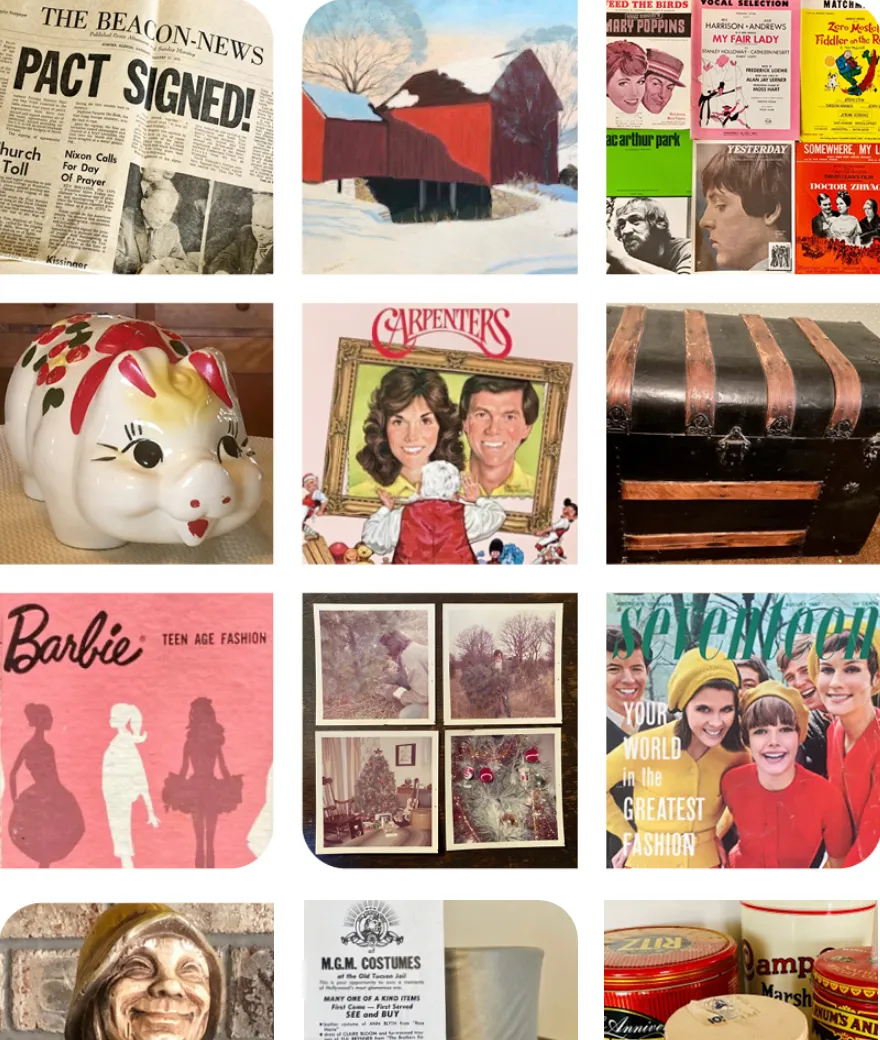Reading time: 7 minutes
If you’ve ever needed a better reason to stick to or create a resolution to declutter your home, this one might do it: It’s good for your brain. And we’ve seen it firsthand.
In today’s piece for ARTIcles by Artifcts, we talk openly about facing a loved one’s dementia diagnosis, and how, maybe to your surprise, decluttering can help. We are grateful to include specialist insights throughout from Cathy Rice, certified senior move manager and life-long educator.
________________
Dementia is heartbreaking, terrifying, and, so far, irreversible. Even if a loved one is in many ways themself, we know the disease is slowly changing them and shortening their life. I know. I have a loved one who is among the more than 50 million people worldwide with dementia now and already lost a loved one to dementia as well.
Some of us react to this sort of diagnosis with a desire to do something, anything, to help, to make our loved one’s life in any way better, to take the tiniest measure of control over the disease. We dive into a multi-prong tactical to-do list that we must continuously update as together we progress from diagnosis, to sharing that diagnosis with others, to learning how to manage the disease and being as prepared as possible across legal, medical, financial, and insurance fronts.
As I sought out my own ways to help, I expected I’d find information about diet, exercise, and social activities, both for my loved one with dementia and their primary, day-to-day care provider. And I did. What I was surprised to find recently while browsing HFC, Shining a Light on Alzheimer's: 5 Brain Health Habits was the hot mainstream topic of decluttering.
Benefits of Decluttering for Those With Dementia
You know decluttering well from TV shows like The Joy of Swedish Death Cleaning and The Home Edit, books including Marie Kondo’s famous The Life-Changing Magic of Tidying Up, and bins and more from shops like The Container Store. Decluttering to support someone with dementia in some ways is like decluttering for people with normal brain health. Too much stuff can literally be dangerous if we cannot safely navigate our homes. Some of us are also more sensitive to feeling drained by too much stuff lying about around us.
Of course, when you have dementia, decluttering has other benefits, too.
-
-
- Reduce stress. Stress reduction is imperative when you have mild cognitive impairment or dementia. And decluttering can mean clearing away some of the to-dos that come to mind when people see stuff to tidy, dust, or keep safe. Have you experienced a loved one with dementia hiding things to keep the item safe? I am sure you have because it's an incredibly common behavior.
- Improve sleep. Quality sleep is critical for the brain’s nightly reset. Busy surroundings can lead to busy brains and may even sow confusion in bedtime routines.
- Safety, safety, safety. We know, decluttering is about aging well in place for all of us as we age, but it’s especially true for people with health conditions, like dementia, that can make them more vulnerable to confusing and distracting surroundings.
- Avoiding anything close to hoarding. Keep in mind, hoarding disorder is its own condition, but managing even the clutter of daily life is more difficult when you have dementia because of increased challenges in making decisions.
- Purpose. We know finding purpose at any age is important. Here we are talking about giving the decluttering process a purpose to help your loved one part with more items than they might otherwise be willing to do. Purpose might be supporting a local shelter, resupplying charitable builders with tools, or reconnecting with loved ones when you pass down items. You get the idea.
Decluttering for Dementia
We’ve prepared these tips from our own practical experience helping our loved ones with dementia as we try to help make sense of it all, including one’s surroundings.* In some cases our loved ones were also decluttering to downsize and move. In others, it was more of a practical decluttering, for safety and mental health.
* We are not medical professionals. If you are considering radical changes to your loved one’s home enviornment, you should consult first with a specialist licensed in dementia care.
LIGHTS ...
Before you start your declutter, check the lighting throughout the home. Living like a cave troll generally does no one very good. But dementia is not only about memory. If you can see well what’s around you, it’s easier to make sense of your surroundings (and of course it’s safer). Make it easy to see the light switches, too. Understanding and interpreting surroundings, like a white switch on a white wall, can become an impediment for someone with dementia.
Cathy’s Insight: Adding felt pads to any lighting fixture to differentiate the feel of the switch from the fixture itself or a simple icon as a visual cue helps to support the brain's understanding of the item with its function.
… CAMERA, ACTION!
Start from the ground, and work your way up.
What’s on the floor? Stacks of stuff? Wandering power cords? Rugs that slip and shift? Take a fresh look. Then move your eye upward to the surfaces of counters and entry tables. If someone needed to quickly grab onto a surface to prevent a fall, would they have a secure place to grab? Is there a clear and secured place for common objects, like house keys?
Cathy’s Insight: People with dementia often find comfort in knowing that their stuff is close-at-hand. Create a "command center" within easy reach of their favorite chair for essentials (eyeglasses, books, pencils, fidget items, etc.).
And about those rugs … if you must keep them, use carpet tape to secure edges to the floor. The same applies to small storage trays, which you can secure with surface-safe tape or museum putty.
Favor simple home furnishings.
As we know stress takes its own toll on the brain; let’s try to minimize the stress home décor can accidentally create. One Arti Member told us, “My loved one was disturbed by a decorative lumbar pillow that had a shaggy fur cover. It looked like a small dog.” Sometimes textures and patterns can be difficult for people with dementia to interpret. Likewise distinguishing whether an object is inanimate. This is why some people with advancing dementia find comfort with life-like pets such as those from Joy For All.
Take it down a notch.
This is about audio clutter. Too much and/or competing noises can be incredibly distracting for anyone, particularly someone with dementia. Think about simultaneous noise from the television, washing machine, and someone on a phone call, for example.
Cathy’s Insight: Taking this point a step further, family, friends, and caregivers should practice standing in front of, and at eye level if appropriate, people with dementia before speaking with them. Get their attention by saying their name and then speak simply and succinctly.
Set it aside, together. Do not remove it.
Don’t remove it immediately, if you do not have to, that is. Rushes to declutter in support of someone with memory loss could lead to irreversible loss of cherished mementos that also can serve as visual cues for familiarity and comfort. Is there an alternative way to display the items that the person with dementia says they care most about? Maybe try grouping like items on a shelf or table where they will see them often. For photos, you might even consider a digital photo frame, such as those from Nixplay, Aura, or any of the many other options.
For items that do not make the cut, if space permits, store them in an appropriate box, and set them aside so you can pull them back out later if needed or as part of a monthly or maybe seasonal rotation. We recommend you Artifct them before they go into the box and tag them to easily recall what you've stored. This approach does not apply to duplicates, meaningless bits and bops, or trash. Consult with your loved one always as well as your own good judgement.

Clarity of Purpose for the Win
Our final decluttering tip is about visual chaos. If you open a drawer and see a jumble of socks, pants, and t-shirts, you could get distracted or confused. If a cabinet has five options for plates, and 10 options for cups, which should you choose? Not only should you streamline what’s inside for simpler decision making but consider visually labeling doors to indicate what’s inside. This gadget could help you get started with easy printing of images from your phone.
Cathy’s Insight: As the disease of dementia progresses, consider only placing the clothes needed for that day in the drawer or use a shelf in a bedroom/bathroom as the place for their daily wardrobe.
Do you have decluttering tips for dementia? We’d love to hear them! You can contact Editor@Artifcts.com.
Happy Artifcting!
_________________
ADDITIONAL REFERENCES
If you are a caregiver or supporting someone who is, you may find it helpful to browse and share these related resources.
Alzheimer's Society, UK: 10 Ways to Make Your Home Dementia Friendly
US National Institute of Health: Study of Home Modifications for People with Dementia
Wisconsin Alzheimer's Institute: Communication Strategies in Dementia Care
Mayo Clinic: Clearing Clutter Benefits Your Health and Well-Being
Psychology Today: The Many Mental Benefits of Decluttering
AARP Michigan: Dementia Resource Guide for Families
###
© 2023 Artifcts, Inc. All Rights Reserved.










 Family history, Artifcted!
Family history, Artifcted!











